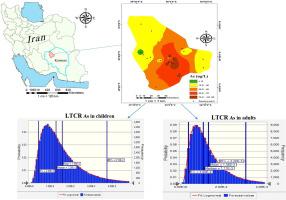Geoscience Frontiers ( IF 8.5 ) Pub Date : 2021-07-24 , DOI: 10.1016/j.gsf.2021.101276 Hadi Eslami 1, 2 , Abbas Esmaeili 1 , Mohsen Razaeian 3 , Mahnaz Salari 4 , Abdolreza Nassab Hosseini 1 , Mohammad Mobini 1 , Ali Barani 4

|
In this study, the concentration and spatial distribution of potentially toxic metals (PTMs), including arsenic (As), cadmium (Cd), chromium (Cr), lead (Pb), copper (Cu), iron (Fe), manganese (Mn), and magnesium (Mg) in 23 wells and drinking groundwater distribution networks of Rafsanjan, located in southeast Iran were evaluated. Moreover, the assessment of carcinogenic and non-carcinogenic risks was estimated by Monte Carlo simulation (MCS). The results showed that the concentrations of As and Pb in more than 99% and 23.46% of the study area, respectively, were higher than the maximum concentration level (10 µg/L). The mean concentration of other metals, including Cd, Cr, Cu, Fe, Mg, and Mn in all drinking water resources was within the WHO standard level. The mean hazard quotient (HQ) for As in the age group of children was 9.246 and adults 2.972, indicating high non-carcinogenic risk of As in the study area. The lifetime cancer risk (LTCR) of As was 1.36E−3 for adults and 1.52E−2 for children, indicating high non-carcinogenic risk of As. The level of HQ and LTCR for Pb in both age groups was in the acceptable range. The results of sensitivity analysis showed that the most effective variables were pollutant concentration and body weight (BW), respectively. Finally, it can be concluded that exposure to PTMs, especially As through drinking water in the study area can have significant effects on people’s health living in the area; therefore, it is necessary to treat and remove As from groundwater resources before drinking or using for domestic purpose.
中文翻译:

伊朗东南部饮用水地下水资源的潜在有毒金属浓度、空间分布和健康风险评估
在本研究中,潜在有毒金属 (PTM) 的浓度和空间分布,包括砷 (As)、镉 (Cd)、铬 (Cr)、铅 (Pb)、铜 (Cu)、铁 (Fe)、锰 ( Mn) 和镁 (Mg) 在位于伊朗东南部的 Rafsanjan 的 23 口井和饮用水地下水分配网络中进行了评估。此外,通过蒙特卡罗模拟(MCS)评估致癌和非致癌风险。结果表明,研究区99%以上和23.46%以上的As和Pb浓度均高于最大浓度水平(10 µg/L)。其他金属,包括Cd、Cr、Cu、Fe、Mg和Mn在所有饮用水资源中的平均浓度均在WHO标准范围内。儿童年龄组中 As 的平均风险商数 (HQ) 为 9.246,成人为 2。972,表明研究区砷的非致癌风险很高。As 的终生癌症风险 (LTCR) 成人为 1.36E-3,儿童为 1.52E-2,表明 As 具有较高的非致癌风险。两个年龄组的 Pb 的 HQ 和 LTCR 水平都在可接受的范围内。敏感性分析结果表明,最有效的变量分别是污染物浓度和体重(BW)。最后,可以得出结论,研究区暴露于 PTMs,尤其是通过饮用水暴露的砷会对生活在该地区的人们的健康产生显着影响;因此,在饮用或用于家庭目的之前,有必要对地下水资源中的砷进行处理和去除。52E-2 为儿童,表明 As 的高非致癌风险。两个年龄组的 Pb 的 HQ 和 LTCR 水平都在可接受的范围内。敏感性分析结果表明,最有效的变量分别是污染物浓度和体重(BW)。最后,可以得出结论,研究区暴露于 PTMs,尤其是通过饮用水暴露的砷会对生活在该地区的人们的健康产生显着影响;因此,在饮用或用于家庭目的之前,有必要对地下水资源中的砷进行处理和去除。52E-2 为儿童,表明 As 的高非致癌风险。两个年龄组的 Pb 的 HQ 和 LTCR 水平都在可接受的范围内。敏感性分析结果表明,最有效的变量分别是污染物浓度和体重(BW)。最后,可以得出结论,研究区暴露于 PTMs,尤其是通过饮用水暴露的砷会对生活在该地区的人们的健康产生显着影响;因此,在饮用或用于家庭目的之前,有必要对地下水资源中的砷进行处理和去除。分别。最后,可以得出结论,研究区暴露于 PTMs,尤其是通过饮用水暴露的砷会对生活在该地区的人们的健康产生显着影响;因此,在饮用或用于家庭目的之前,有必要对地下水资源中的砷进行处理和去除。分别。最后,可以得出结论,研究区暴露于 PTMs,尤其是通过饮用水暴露的砷会对生活在该地区的人们的健康产生显着影响;因此,在饮用或用于家庭目的之前,有必要对地下水资源中的砷进行处理和去除。











































 京公网安备 11010802027423号
京公网安备 11010802027423号